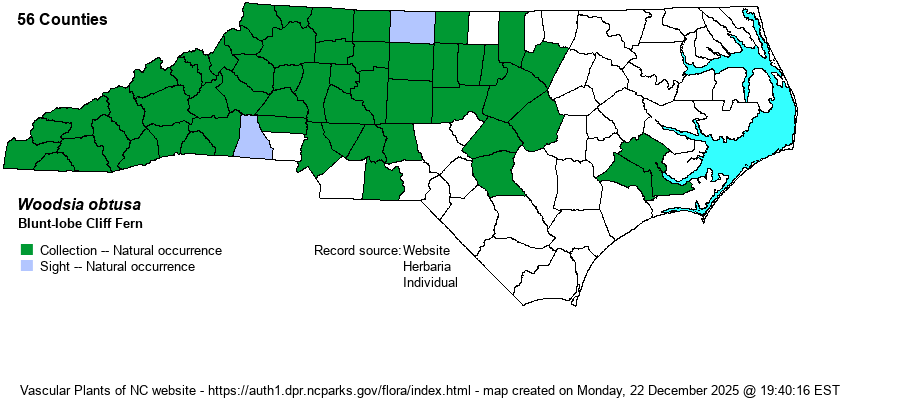| Author | (Sprengel) Torrey | |
| Distribution | Throughout the Mountains and Piedmont; known in the Coastal Plain from just a few sites (Craven, Jones, and Cumberland counties). A specimen at NCU from "Columbus" County is actually from Cumberland (Clark Park in Fayettevile).
This is a widespread Eastern species, found from eastern Canada south to the FL Panhandle and central TX. It is scarce in the Atlantic Coastal Plain, however. | |
| Abundance | Fairly common to frequent in the mountains, and infrequent to locally fairly common in the Piedmont; however, very rare in the Coastal Plain, apparently limited to a few sites with marl outcroppings (Jones and Craven counties) and clay walls of a waterfall in Cumberland County. | |
| Habitat | This is a rock-inhabiting species, but has a wide tolerance of rock types and locations. It grows around the margins of granitic flatrocks, in crevices of cliffs and rocky summits, in rocky woods, and even from rock walls and other masonry. It can be found at both calcareous/mafic and felsic rock types. The population in Cumberland County occurs uniquely on clay walls of a 35-foot high intermittent waterfall. |
| Phenology | Fruits from May to October. | |
| Identification | This is a somewhat frequently seen rock-loving fern in the mountains and Piedmont, but even so, it is somewhat limited on the landscape to rock outcroppings and thus is not seen on most walks. The stipe is buffy-colored, often about 4 inches long; the blade is semi-evergreen, lanceolate to narrowly ovate in shape, tapered to the apex but also somewhat tapered at the base, being widest near the middle of the blade. The blade is bipinnately cut, almost pinnatifid also (with the pinnules cut partly to their midribs), about 8-10 inches long and 3-4 inches wide, somewhat larger than those of the other two Woodsia species. Much of the undersides of the pinnules is covered by the rounded sori, though they are in discrete "balls". Cheilanthes lanosa grows in similar places and can look somewhat like Woodsia, but it has a hairier frond and the sori are in continuous bands around the margins of the pinnules, which are most strongly curled downward. Separation of the three Woodsia species, as well as the several Cystopteris species, can be quite difficult without a hand lens. Woodsia species have "the indusium divided into a series of scale-like or hair-like structures, attached below the sorus; Cystopteris has an undivided indusium, pocket-like or hood-like, attached around one side of the sorus. Woodsia has persistent dark petiole bases; in Cystopteris the petiole bases are deciduous. Woodsia has the final veinlets not reaching the margins; Cystopteris veins do reach the margin." (Weakley 2018). Within Woodsia, this species can be separated from the more widespread W. obtusa by having "Pinnae with numerous long whitish scales", versus W. obtusa having "Pinnae without scales, a few broad scales on the midrib" (Wofford 1989). W. ilvensis has the petioles "with a distinct joint about 1-3 cm above the base" (Weakley 2018), such that former blades leave a rather even stubble, as opposed to the other two that lack such a joint, and the former leaves having an uneven stubble of broken stipes. | |
| Taxonomic Comments | The form found in NC is the nominate subspecies -- ssp. obtusa.
| |
| Other Common Name(s) | Common Woodsia, Blunt-lobe Woodsia | |
| State Rank | S5 | |
| Global Rank | G5 | |
| State Status | | |
| US Status | | |
| USACE-agcp | | |
| USACE-emp | | |

